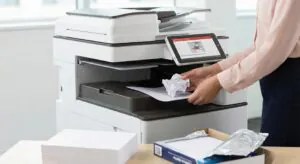What We’ll Cover in This Article
- Why office print hasn’t disappeared (and why it still matters)
- How printed documents fit into modern digital workflows
- Practical examples of indexing, access, and security gains
- ROI considerations for balancing digital and print
- Questions leaders should ask when assessing print strategy
Introduction: So…Is Print Really Dead?
Every few years, someone declares the “death of print.” Yet if you look around your office—or your clients’ offices—you’ll still see printed documents in daily use. The truth is not that print died. It evolved.
Printed materials have shifted from “everything goes on paper” to strategic, high-value uses: legal records, annotated work packets, patient forms, executive summaries, branded proposals. Instead of competing with digital workflows, print now complements them. The organizations that thrive are those that integrate print into secure, indexed, and quickly retrievable document ecosystems.
Why Print Didn’t Disappear in the Digital Shift
1. Human factors: Comprehension and trust
Research shows that many people still retain information better from paper than screens, especially for long or complex content (e.g., legal contracts, technical drawings). In meetings, a well-laid-out printed packet still carries authority.
2. Regulatory and compliance drivers
Industries like healthcare, law, and finance often require hard copies for retention or compliance. Digital records are essential, but physical copies are still trusted for audits, client confidence, and redundancy .
3. Hybrid work realities
Remote teams rely on digital files, but offices still need shared devices for signed documents, physical notices, and customer-facing materials. Hybrid models demand secure, right-sized print fleets that align with digital workflows .
How Print Has Evolved Into a Strategic Role
Print management and automation
Managed Print Services (MPS) standardizes devices, automates supplies, and enables secure print/pull release. This reduces wasted prints and strengthens confidentiality .
Doceo Pro Tip: Secure print/pull release isn’t just about reducing unclaimed pages. It’s about keeping sensitive client information from sitting unprotected on trays.
Workflow integration
Today’s printers are multifunction devices (MFPs). They’re not just output machines—they’re gateways into digital workflows. Scanning directly into document management systems with consistent naming conventions makes retrieval far easier than digging through email chains.
Indexing and quick access
Software like PaperCut enables indexing and reporting. Leaders can see which departments print most, apply rules (like default duplex), and reduce spend—all while making records searchable and auditable .
Doceo Pro Tip: Pair scanning workflows with index templates (e.g., client ID + date). It reduces errors and accelerates retrieval across teams.
ROI: Print as a Cost Center or Value Driver?
Let’s do some simple math.
- Baseline: An office of 100 employees prints ~4,000 pages/month at $0.06/page = $240/month.
- With secure release + duplex defaults: volume drops ~25% (to 3,000 pages).
- New run-rate = $180/month. Annualized, that’s a $720 savings—without reducing effectiveness.
Multiply those numbers across multiple devices, or factor in fewer service calls from right-sized fleets, and the value becomes obvious .
Questions Leaders Should Be Asking
- How are our devices secured and monitored?
- Do we have the right mix of A3 (ledger-capable) and A4 (letter/legal) devices?
- What percentage of our prints are unclaimed or waste?
- Can we search, retrieve, and index documents as easily as we print them?
- Are our print policies aligned with compliance requirements?
Asking these questions reframes print not as a legacy cost, but as a strategic asset in your organization’s information ecosystem.
FAQs About Modern Print
What does managed print actually include?
Standardized devices, supplies automation, secure release, proactive service, and cost tracking .
How does secure print work?
Users authenticate at the device to release jobs—reducing unclaimed prints and protecting sensitive data .
How do we measure print costs?
Print management tools like PaperCut report cost per page, device utilization, and waste, making cost control actionable .
Conclusion: Print Is Here—Just Smarter
Print isn’t extinct. It’s evolved into a leaner, smarter, and more secure part of the office. By pairing modern print technology with digital workflows, leaders gain the best of both worlds: paper where it adds value, and digital where it accelerates access.
👋 Have questions or want to talk through your options? We’re here to help. Chat with a Doceo Print Technology Advisor today: Let's Talk





